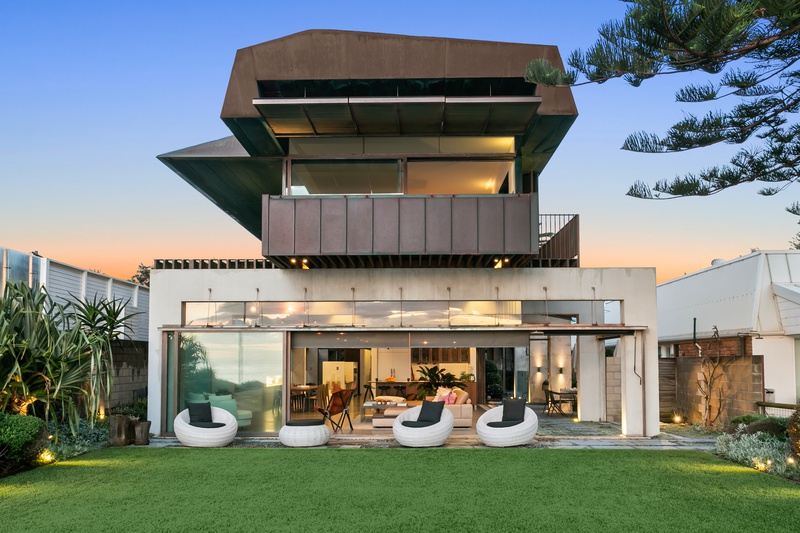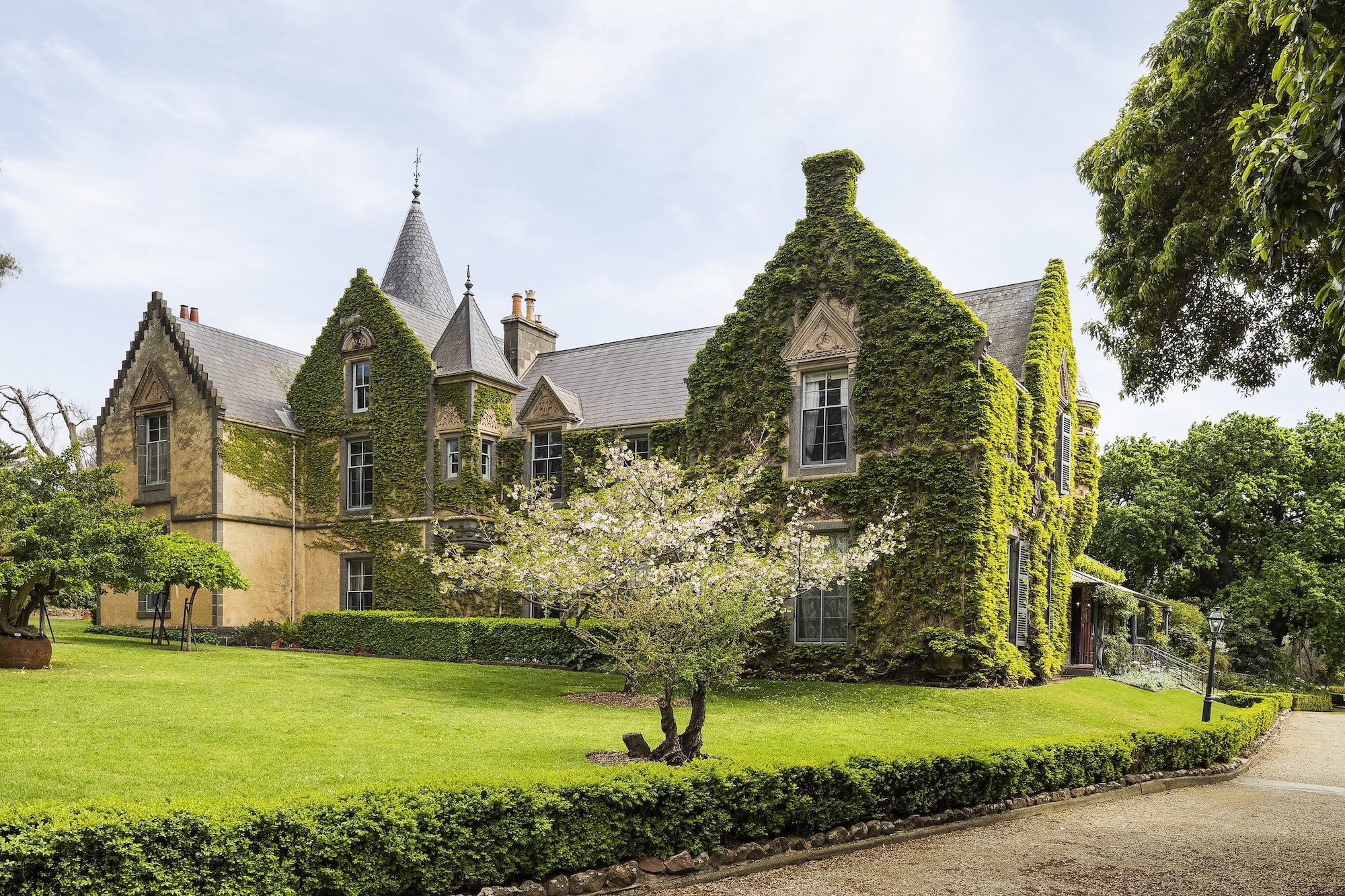Jamie Durie’s amazing waterfront home for sale with a $33m price tag
A showcase of sustainable luxury, Belah House rises from Stokes Point with sandstone, vertical gardens and off-grid capability.
Anchored into the cliffs of Stokes Point overlooking Pittwater, their recently completed eco mansion was designed by Silvester Fuller Architects in collaboration with the Backyard Blitz and The Block alumni and builder Antoine Gittany, from Dilcara.
The six-bedroom, six-bathroom, two-car garage home also features in the first season of Durie’s latest show, Growing Home.
Despite Durie reportedly knocking back an offer of $30 million earlier this year – and the couple revealing to media that money couldn’t buy the experience of living life in their eco dream home – the Northern Beaches residence has come to market this week with a $33 million price tag through McGrath Pittwater agent James Baker.
The high-profile pair are reportedly moving to the Byron Bay hinterland. Crafted to define what it means to live harmoniously with nature, Belah House is set over four levels on a dramatically elevated 1017sq m block on the prestigious peninsula. The enviable beach house has about 720sq m of internal living with seamless spaces flowing through to the great outdoors.
Wrapped in sandstone, with vertical gardens and carefully curated native greenery throughout the site, the property had been orientated to connect with the vast bushland of Ku-ring-gai National Park.
As a horticulturalist by trade and a sustainability advocate in practice, Durie is best known for his design programs, including appearances on The Oprah Winfrey Show. The couple poured five years of research into their Avalon project, treating their own home as a test run for revolutionary technology to change the way Australians live with nature at home.
The house sits high on seven geothermal probes sunk 120m into the earth to harness the ground temperature to heat or cool the home, as well as its zero-chemical infinity-edge pool, and hydronic floors.
The property features 42 solar panels, a 20kW Skybox solar system for near-total energy independence, and water harvesting systems that recycle every drop. The concrete has been engineered with up to 75 per cent reduced carbon emissions, and the Control4 Smart Home system manages elements from climate control to lighting and irrigation.
Inside Belah House, there are multiple living areas inside and out, walls of glass to capture the outlook, a gourmet open-plan kitchen with a butler’s pantry and coffee station, as well as a full bar and terrace on the same level.
The lower ground floor is home to a palatial main bedroom with dual walk-in wardrobes, a large ensuite with a freestanding tub overlooking the water and three more bedrooms, including one with its own ensuite.
Additional features at the property include a media room, a self-contained guest suite, home cinema, wine cellar, outdoor kitchen, infinity pool, 160sq m rooftop garden containing a vegetable patch, interior hanging gardens, and a wellness retreat complete with a gym, sauna, steam room, plus ice bath.
A 35-metre inclinator services the 37-degree slope to private deep-water facilities, including a jetty, slipway, and grotto entertainment space carved into the natural rock.
Belah House at Avalon Beach is on the market with James Baker of McGrath Pittwater for $33 million via an expressions of interest campaign that closes at 5 pm on November 11.
Records keep falling in 2025 as harbourfront, beachfront and blue-chip estates crowd the top of the market.
A divide has opened in the tech job market between those with artificial-intelligence skills and everyone else.
The 2026 McGrath Report warns that without urgent reforms to planning, infrastructure and construction, housing affordability will continue to slip beyond reach for most Australians.
Australia’s housing market has reached a critical juncture, with home ownership and rental affordability deteriorating to their worst levels in decades, according to the McGrath Report 2026.
The annual analysis from real estate entrepreneur John McGrath paints a sobering picture of a nation where even the “lucky country” has run out of luck — or at least, out of homes.
New borrowers are now spending half their household income servicing loans, while renters are devoting one-third of their earnings to rent.
The time needed to save a 20 per cent deposit has stretched beyond ten years, and the home price-to-income ratio has climbed to eight times. “These aren’t just statistics,” McGrath writes. “They represent real people and real pain.”
McGrath argues that the root cause of Australia’s housing crisis is not a shortage of land, but a shortage of accessibility and deliverable stock.
“Over half our population has squeezed into just three cities, creating price pressure and rising density in Sydney, Melbourne and Brisbane while vast developable land sits disconnected from essential infrastructure,” he says.
The report identifies three faltering pillars — supply, affordability and construction viability — as the drivers of instability in the current market.
Developers across the country, McGrath notes, are “unable to make the numbers work” due to labour shortages and soaring construction costs.
In many trades, shortages have doubled or tripled, and build costs have surged by more than 30 per cent, stalling thousands of projects.
Need for systemic reform
McGrath’s prescription is clear: the only real solution lies in increasing supply through systemic reform. “We need to streamline development processes, reduce approval timeframes and provide better infrastructure to free up the options and provide more choice for everyone on where they live,” he says.
The 2026 edition of the report also points to promising trends in policy and innovation. Across several states, governments are prioritising higher-density development near transport hubs and repurposing government-owned land with existing infrastructure.
Build-to-rent models are expanding, and planning reforms are gaining traction. McGrath notes that while these steps are encouraging, they must be accelerated and supported by new construction methods if Australia is to meet demand.
One of the report’s key opportunities lies in prefabrication and modular design. “Prefabricated homes can be completed in 10–12 weeks compared to 18 months for a traditional house, saving time and money for everyone involved,” McGrath says.
The report suggests that modular and 3D-printed housing could play a significant role in addressing shortages while setting a new global benchmark for speed, cost and quality in residential construction.
Intelligent homes
In a section titled Weathering the Future: The Power of Smart Design, the report emphasises that sustainable and intelligent home design is no longer aspirational but essential.
It highlights new technologies that reduce energy use, improve thermal efficiency, and make homes more resilient to climate risks.
“There’s no reason why Australia shouldn’t be a world leader in innovative design and construction — and many reasons why we should be,” McGrath writes.
Despite the challenges, the tone of the 2026 McGrath Report is one of cautious optimism. Demand is expected to stabilise at around 175,000 households per year from 2026, and construction cost growth is finally slowing. Governments are also showing a greater willingness to reform outdated planning frameworks.
McGrath concludes that the path forward requires bold decisions and collaboration between all levels of government and industry.
“Australia has the land, demand and capability,” he says. “What we need now is the will to implement supply-focused solutions that address root causes rather than symptoms.”
“Only then,” he adds, “can we turn the dream of home ownership back into something more than a dream.”
Once a sleepy surf town, Noosa has become Australia’s prestige property hotspot, where multi-million dollar knockdowns, architectural showpieces and record-setting sales are the new normal.
From Italy’s $93,000-a-night villas to a $20,000 Bowral château, a new global ranking showcases the priciest Airbnbs available in 2026.

























